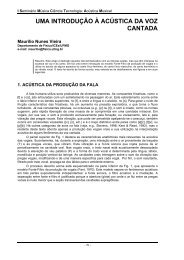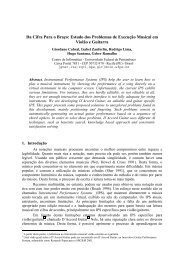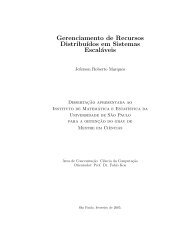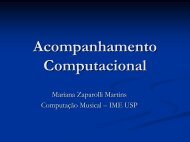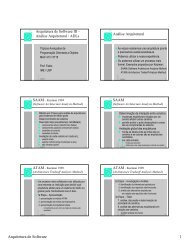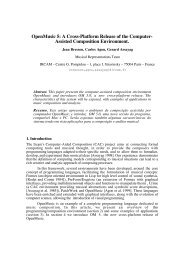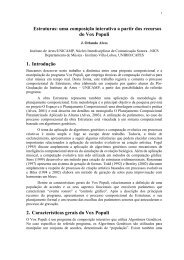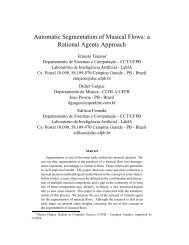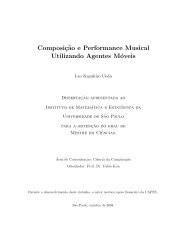Comparative study of measured acoustic parameters in concert halls ...
Comparative study of measured acoustic parameters in concert halls ...
Comparative study of measured acoustic parameters in concert halls ...
Create successful ePaper yourself
Turn your PDF publications into a flip-book with our unique Google optimized e-Paper software.
Table 1: Acoustic Parameters<br />
Subjective Parameter Objective Index Physical Expression<br />
Liveness RT 60 Schroeder (1965)<br />
Warmth<br />
Brilliance<br />
BR<br />
TR<br />
€<br />
RT 125<br />
+ RT 250<br />
RT 500<br />
+ RT 1000<br />
RT + RT<br />
RT<br />
2000<br />
500<br />
+ RT<br />
Ratio D/R RDR 10 log [ Ed / Er ]<br />
Intimacy<br />
Clarity<br />
Def<strong>in</strong>ition<br />
Spatial Impression<br />
ITDG<br />
C80<br />
D50 €<br />
IACC<br />
LF<br />
max<br />
⎡<br />
⎢<br />
€<br />
10log<br />
⎢<br />
⎢<br />
⎢<br />
⎣<br />
80ms<br />
∫<br />
0<br />
t f<br />
∫<br />
4000<br />
1000<br />
t d<br />
− t r<br />
⎤<br />
p 2 (t)dt⎥<br />
⎥<br />
⎥<br />
p 2 (t)dt⎥<br />
⎦<br />
80ms<br />
50ms<br />
∫<br />
0<br />
t<br />
f<br />
∫<br />
0<br />
2<br />
p ( t)<br />
dt<br />
2<br />
p ( t)<br />
dt<br />
−<br />
2<br />
2<br />
[ p ( t)<br />
p ( t + ) dt][ ⋅ p ( t)<br />
dt p ( t)<br />
dt] 1/ 2<br />
e d<br />
α<br />
e<br />
d<br />
∫<br />
80ms<br />
2<br />
∫ plat<br />
5ms<br />
80ms<br />
2<br />
∫ pomni<br />
0<br />
∫<br />
( t)<br />
dt<br />
( t)<br />
dt<br />
∫<br />
3. THEORY AND PROCEDURES FOR OBTAINING ACOUSTICAL PARAMETERS<br />
In terms <strong>of</strong> <strong>acoustic</strong>s, a room designed for musical purposes can be seen as a l<strong>in</strong>ear system.<br />
One <strong>of</strong> the ma<strong>in</strong> characteristics <strong>of</strong> a l<strong>in</strong>ear system is its impulse response (IR), that is, the<br />
reaction <strong>of</strong> the system to an impulsive signal. The IR can be understood as the "<strong>acoustic</strong>al<br />
signature " <strong>of</strong> a room, and all the <strong>acoustic</strong> <strong>parameters</strong> can be extracted from it. The Fourier<br />
Transform <strong>of</strong> the IR h (t) is the frequency response H (w), also called Transfer Function.<br />
From the signal theory we know that the output y (t) <strong>of</strong> the l<strong>in</strong>ear time <strong>in</strong>variant system is the<br />
convolution between the <strong>in</strong>put x (t) with the impulse response h (t). In the frequency doma<strong>in</strong><br />
it is equivalent to the multiplication <strong>of</strong> both X (w) and H (w) transfer functions:<br />
Y(w) = X(x) . H(w) (1)<br />
3.1 Obta<strong>in</strong><strong>in</strong>g the IR<br />
The literature <strong>in</strong>dicates two ways for obta<strong>in</strong><strong>in</strong>g the IR. The first one is known as MLS



